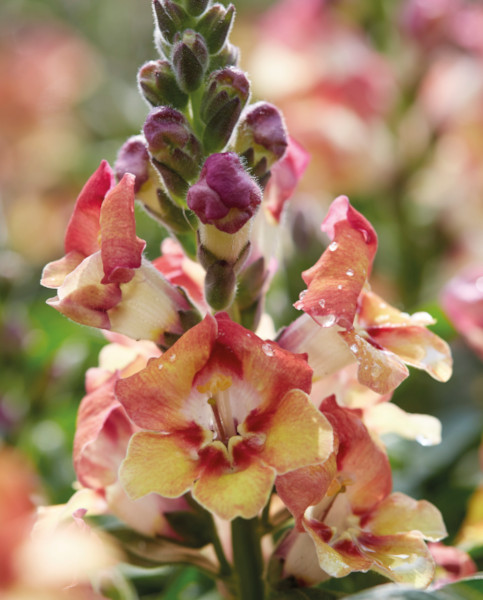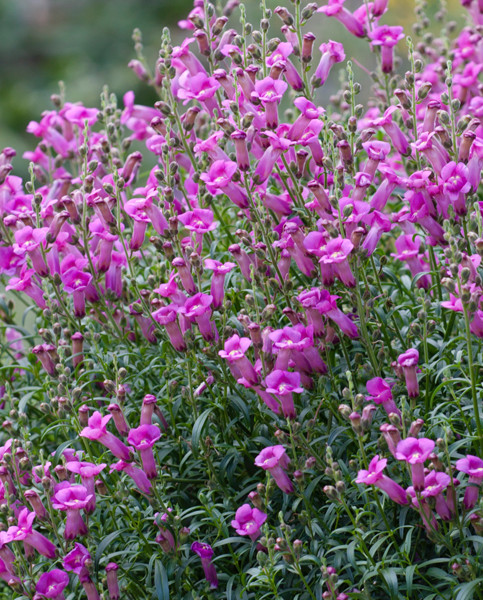How to grow Antirrhinum
Antirrhinum can be annual or perennial depending on the species, though with limited hardiness both types tend to be grown as annual bedding in our UK climate. They are cultivated for their abundant flowers produced over a long period in a range of bright, cheerful colours.
Antirrhinum is also known by the common name of snapdragon. When squeezed, its flowers open and close like the jaws of a dragon.

Key Information
Soil pH
Position
Hardiness


Where to plant Antirrhinum
For best results, plant in spring once the last risk of frost has passed. This varies from region to region, though tends to be around May. Planting can also be carried out in summer, though be prepared to water regularly.
Antirrhinum is equally happy in the ground or in a container. Its natural fit is with a traditional cottage garden style scheme. It also suits a family garden (children love to play with the snapping flowers), or in a cut flower border (its sturdy stems last well in a vase).
How to plant Antirrhinum
In the ground
- Clear the chosen area of weeds.
- Dig a planting hole several times larger than the root ball. It is a good idea to mix in plenty of horticultural grit and some well-rotted organic matter at this stage.
- Place the plant in the hole, ensuring the top of the root ball sits level with the surface of the soil. Too low and the plant may rot, too high and the roots can dry out.
- Backfill with soil and firm in gently.
- Soak well with water.
- Mulch around the base with well-rotted organic matter.
In a container
- Choose an appropriate container with plenty of drainage holes.
- Use a good quality potting compost with plenty of horticultural grit mixed in, and, if not already present in the compost (check the description on the bag) some slow-release feed.
- It can be a good idea to fill and plant larger containers in situ to save yourself the trouble of moving them once full.
- Start by partially filling the pot with compost; enough so that when placed on it the upper surface of the root ball is about 3cm lower than the top of the pot.
- Infill all the space surrounding the root ball with compost, firming down with your fingers then adding a little more so the plant is held tight.
- Pick up the pot (if you can!) and lightly tap on the ground a few times to help further settle the compost around the plant.
- Soak well with water.
- A mulch with horticultural grit will look attractive and help to prevent a ‘cap’ or crust forming on the top of the compost (something container plants can suffer due to the artificial nature of their watering).

How to care for Antirrhinum
Pruning and Deadheading
Deadhead regularly to prolong flowering. Picking newly opened flower spikes as cut flowers also encourages further blooming.
Watering
For best results keep your antirrhinum well-watered. For those in the ground this can mean once a week if the weather is dry, and container-grown plants will need attention even more frequently.
Cold Protection
Both annual and perennial antirrhinum tend to be treated as annuals by most UK gardeners (which means removing and composting plants at the end of the summer). However, you may wish to have a go at overwintering perennial varieties by growing them in a container and moving into a greenhouse or conservatory when temperatures drop. Chop the whole plant back by around half if you do move it inside.
Pests and Diseases
Antirrhinum tend to be trouble-free.
How to propagate Antirrhinum
Though unlikely to come true to the parent plant, collecting and sowing antirrhinum seed can still offer good results. Simply leave a few spent flowerheads on the plant to allow the formation of seed.
- Seeds are typically ready for collecting in late summer to early autumn when the seedheads have dried and turned brown.
- Snip the seedheads from the plant using scissors or secateurs. Try to do this in dry conditions, and place in a small paper bag or envelope.
- Either sow straight away (and overwinter seedlings in a frost-free environment) or store the seeds somewhere cool and dry and sow in spring. Whether you choose an autumn or spring sowing, the process is as follows.
- Fill a seed tray or small pot with a very well-draining compost mix.
- Sprinkle the seeds evenly over the surface of the compost, pressing lightly into the soil with a flat piece of wood or the bottom of another pot. Don’t bury them too deeply.
- Use a garden sieve to cover with a fine layer of compost.
- Water the soil gently with a fine spray until it is evenly moist but not waterlogged.
- Cover the seed tray with a clear plastic lid or plastic wrap to create a mini-greenhouse effect. This helps maintain consistent humidity. Label the tray or pots.
- Place the covered seed tray or pots in a coldframe or unheated greenhouse.
- Check periodically to ensure the soil remains evenly moist but not waterlogged.
- Once you notice seedlings emerging, remove the cover.
- When the seedlings have grown large enough to handle, transplant them into individual pots filled with a very gritty mix.
- Water regularly but avoid overwatering.
- Grow on in a protected, frost-free environment until the last risk of frost has passed (usually around May), and they look beefy enough to fend for themselves. Follow our ‘How to plant antirrhinum’ guide above.
Common Antirrhinum questions
- Do antirrhinums come back every year?
Some antirrhinum species (e.g. Antirrhinum majus and its cultivars) are annual, so will grow, flower, set seed, and die within one year. Others, such as ‘Pretty in Pink’, and ‘Oh That’s Cute’ are short-lived perennials, meaning they can come back for another year, maybe two, if kept in a frost-free environment over winter. See our ‘Cold protection’ section above for more details. - Are antirrhinum easy to grow?
Provided you can give them a sunny, well-draining spot and water during dry spells, these plants are a fantastically easy way to achieve masses of brightly coloured flowers. - Do antirrhinum like sun or shade?
These sun worshippers are likely to struggle in a shaded position. Give them your sunniest spot for best results.




